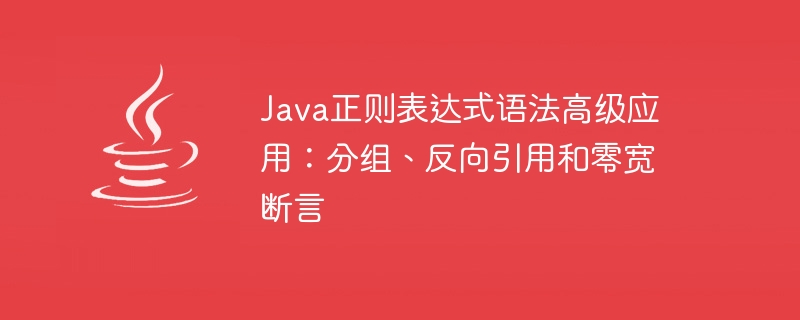Home >Java >javaTutorial >Advanced applications of Java regular expression syntax: grouping, backreferences, and zero-width assertions
Advanced applications of Java regular expression syntax: grouping, backreferences, and zero-width assertions
- 王林Original
- 2023-12-26 11:52:49728browse

Advanced applications of Java regular expression syntax: grouping, backreferences, and zero-width assertions
正则表达式是一种强大的文本处理工具,在Java中使用正则表达式,可以非常方便地进行字符串的匹配、查找和替换等操作。除了基础的正则表达式语法之外,还有一些高级的语法和功能,如分组、反向引用和零宽断言,本文将详细介绍这几个概念,并给出具体的代码示例。
- 分组(Grouping)
在正则表达式中,我们可以使用小括号将一个或多个字符组合成一个子表达式,从而形成一个分组。分组可以使正则表达式更加灵活,可以对分组进行重复、替换或者引用等操作。
例如,我们可以使用分组来匹配出一串连续的数字和字母的组合: d{3}([a-z]+)d{3}
在这个正则表达式中,d{3}表示匹配三个数字,[a-z]+表示匹配一个或多个字母,d{3}表示再次匹配三个数字。小括号([a-z]+)将字母组成的子表达式进行分组。
下面是一个具体的代码示例:
import java.util.regex.*;
public class GroupingExample {
public static void main(String[] args) {
String input = "123abc456";
String regex = "\d{3}([a-z]+)\d{3}";
Pattern pattern = Pattern.compile(regex);
Matcher matcher = pattern.matcher(input);
if (matcher.find()) {
String group = matcher.group(1);
System.out.println("Group: " + group);
}
}
}输出结果为: Group: abc
- 反向引用(Backreference)
在正则表达式中,我们可以使用反向引用来引用前面的分组。反向引用使用类似于数字的形式,数字表示分组的序号。使用反向引用,我们可以快速找到和前面某个分组相同的内容。
例如,我们可以使用反向引用来匹配出相同的连续字符: ([a-z])+
在这个正则表达式中,([a-z])表示匹配一个字母,并将其分组,表示引用第一个分组,+表示匹配一个或多个。
下面是一个具体的代码示例:
import java.util.regex.*;
public class BackreferenceExample {
public static void main(String[] args) {
String input = "aabbbbccccdd";
String regex = "([a-z])\1+";
Pattern pattern = Pattern.compile(regex);
Matcher matcher = pattern.matcher(input);
while (matcher.find()) {
String group = matcher.group();
System.out.println("Group: " + group);
}
}
}输出结果为: Group: aa Group: bbbb Group: cccc Group: dd
- 零宽断言(Zero-width assertions)
零宽断言是一种特殊的正则表达式语法,它用于限定匹配的位置,而不是匹配实际的字符。零宽断言有四种类型:正向肯定先行断言(Positive Lookahead)、正向否定先行断言(Negative Lookahead)、正向肯定后发断言(Positive Lookbehind)和正向否定后发断言(Negative Lookbehind)。
例如,我们可以使用零宽断言来匹配前面是数字的字母: (?在这个正则表达式中,(?
下面是一个具体的代码示例:
import java.util.regex.*;
public class ZeroWidthAssertionExample {
public static void main(String[] args) {
String input = "123abc456def";
String regex = "(?<=\d)[a-z]+";
Pattern pattern = Pattern.compile(regex);
Matcher matcher = pattern.matcher(input);
while (matcher.find()) {
String group = matcher.group();
System.out.println("Group: " + group);
}
}
}输出结果为: Group: abc Group: def
本文介绍了Java正则表达式语法高级应用中的分组、反向引用和零宽断言三个概念,并给出了具体的代码示例。这些高级功能可以增强正则表达式的灵活性和功能性,帮助我们更高效地处理字符串。通过深入了解和熟练掌握这些高级应用,我们可以更好地使用正则表达式进行文本处理。
The above is the detailed content of Advanced applications of Java regular expression syntax: grouping, backreferences, and zero-width assertions. For more information, please follow other related articles on the PHP Chinese website!

